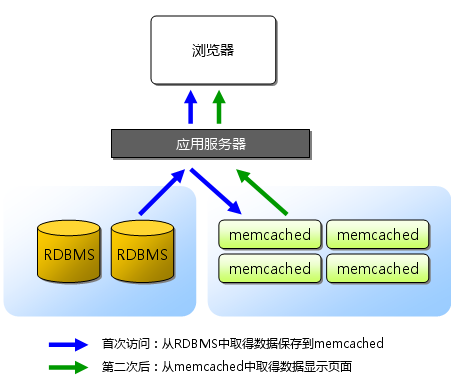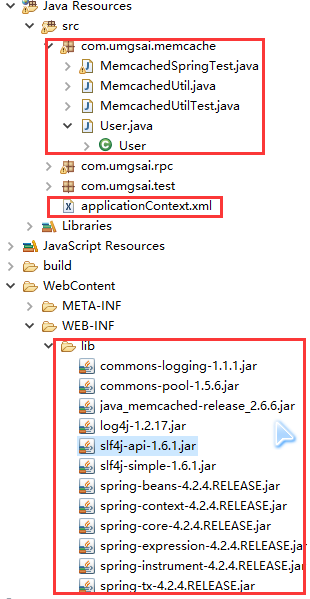Java使用memcache示例
2016-05-24 22:15
183 查看
许多Web应用都将数据保存到RDBMS中,应用服务器从中读取数据并在浏览器中显示。 但随着数据量的增大、访问的集中,就会出现RDBMS的负担加重、数据库响应恶化、 网站显示延迟等重大影响。这时就该memcached大显身手了。memcached是高性能的分布式内存缓存服务器。 一般的使用目的是,通过缓存数据库查询结果,减少数据库访问次数,以提高动态Web应用的速度、 提高可扩展性。

Windows系统下memcache的安装
cmd进入到memcache目录下(win10需要以管理员身份运行cmd)

memcache.exe -d install
memcache.exe -d start
启动memcache服务后可以在windows服务中看到名称为memcache 的服务
Java使用memcache
项目目录如下

User.java
[code=java;toolbar:false">public class User implements Serializable{
private static final long serialVersionUID = 1L;
private String username;
private String password;
//省略构造函数级getter setter
@Override
public int hashCode() {
final int prime = 31;
int result = 1;
result = prime * result
+ ((password == null) ? 0 : password.hashCode());
result = prime * result
+ ((username == null) ? 0 : username.hashCode());
return result;
}
@Override
public boolean equals(Object obj) {
if (this == obj)
return true;
if (obj == null)
return false;
if (getClass() != obj.getClass())
return false;
User other = (User) obj;
if (password == null) {
if (other.password != null)
return false;
} else if (!password.equals(other.password))
return false;
if (username == null) {
if (other.username != null)
return false;
} else if (!username.equals(other.username))
return false;
return true;
}
}
MemcachedUtil.javapublic class MemcachedUtil {
/**
* memcached客户端单例
*/
private static MemCachedClient cachedClient = new MemCachedClient();
/**
* 初始化连接池
*/
static {
//获取连接池的实例
SockIOPool pool = SockIOPool.getInstance();
//服务器列表及其权重
String[] servers = {"127.0.0.1:11211"};
Integer[] weights = {3};
//设置服务器信息
pool.setServers(servers);
pool.setWeights(weights);
//设置初始连接数、最小连接数、最大连接数、最大处理时间
pool.setInitConn(10);
pool.setMinConn(10);
pool.setMaxConn(1000);
pool.setMaxIdle(1000*60*60);
//设置连接池守护线程的睡眠时间
pool.setMaintSleep(60);
//设置TCP参数,连接超时
pool.setNagle(false);
pool.setSocketTO(60);
pool.setSocketConnectTO(0);
//初始化并启动连接池
pool.initialize();
//压缩设置,超过指定大小的都压缩
// cachedClient.setCompressEnable(true);
// cachedClient.setCompressThreshold(1024*1024);
}
private MemcachedUtil(){
}
public static boolean add(String key, Object value) {
return cachedClient.add(key, value);
}
public static boolean add(String key, Object value, Integer expire) {
return cachedClient.add(key, value, expire);
}
public static boolean put(String key, Object value) {
return cachedClient.set(key, value);
}
public static boolean put(String key, Object value, Integer expire) {
return cachedClient.set(key, value, expire);
}
public static boolean replace(String key, Object value) {
return cachedClient.replace(key, value);
}
public static boolean replace(String key, Object value, Integer expire) {
return cachedClient.replace(key, value, expire);
}
public static Object get(String key) {
return cachedClient.get(key);
}
}
MemcachedUtilTest.java测试类public class MemcachedUtilTest {
@Test
public void testMemcached() {
MemcachedUtil.put("hello", "world", 60);
String hello = (String) MemcachedUtil.get("hello");
Assert.assertEquals("world", hello);
for(int i = 0; i < 10000; ++i) {
User user = new User("Jason" + i, "123456-" + i);
MemcachedUtil.put("user" + i, user, 60);
Object obj = MemcachedUtil.get("user" + i);
Assert.assertEquals(user, obj);
}
}
}

Windows系统下memcache的安装
cmd进入到memcache目录下(win10需要以管理员身份运行cmd)

memcache.exe -d install
memcache.exe -d start
启动memcache服务后可以在windows服务中看到名称为memcache 的服务
Java使用memcache
项目目录如下

User.java
[code=java;toolbar:false">public class User implements Serializable{
private static final long serialVersionUID = 1L;
private String username;
private String password;
//省略构造函数级getter setter
@Override
public int hashCode() {
final int prime = 31;
int result = 1;
result = prime * result
+ ((password == null) ? 0 : password.hashCode());
result = prime * result
+ ((username == null) ? 0 : username.hashCode());
return result;
}
@Override
public boolean equals(Object obj) {
if (this == obj)
return true;
if (obj == null)
return false;
if (getClass() != obj.getClass())
return false;
User other = (User) obj;
if (password == null) {
if (other.password != null)
return false;
} else if (!password.equals(other.password))
return false;
if (username == null) {
if (other.username != null)
return false;
} else if (!username.equals(other.username))
return false;
return true;
}
}
MemcachedUtil.javapublic class MemcachedUtil {
/**
* memcached客户端单例
*/
private static MemCachedClient cachedClient = new MemCachedClient();
/**
* 初始化连接池
*/
static {
//获取连接池的实例
SockIOPool pool = SockIOPool.getInstance();
//服务器列表及其权重
String[] servers = {"127.0.0.1:11211"};
Integer[] weights = {3};
//设置服务器信息
pool.setServers(servers);
pool.setWeights(weights);
//设置初始连接数、最小连接数、最大连接数、最大处理时间
pool.setInitConn(10);
pool.setMinConn(10);
pool.setMaxConn(1000);
pool.setMaxIdle(1000*60*60);
//设置连接池守护线程的睡眠时间
pool.setMaintSleep(60);
//设置TCP参数,连接超时
pool.setNagle(false);
pool.setSocketTO(60);
pool.setSocketConnectTO(0);
//初始化并启动连接池
pool.initialize();
//压缩设置,超过指定大小的都压缩
// cachedClient.setCompressEnable(true);
// cachedClient.setCompressThreshold(1024*1024);
}
private MemcachedUtil(){
}
public static boolean add(String key, Object value) {
return cachedClient.add(key, value);
}
public static boolean add(String key, Object value, Integer expire) {
return cachedClient.add(key, value, expire);
}
public static boolean put(String key, Object value) {
return cachedClient.set(key, value);
}
public static boolean put(String key, Object value, Integer expire) {
return cachedClient.set(key, value, expire);
}
public static boolean replace(String key, Object value) {
return cachedClient.replace(key, value);
}
public static boolean replace(String key, Object value, Integer expire) {
return cachedClient.replace(key, value, expire);
}
public static Object get(String key) {
return cachedClient.get(key);
}
}
MemcachedUtilTest.java测试类public class MemcachedUtilTest {
@Test
public void testMemcached() {
MemcachedUtil.put("hello", "world", 60);
String hello = (String) MemcachedUtil.get("hello");
Assert.assertEquals("world", hello);
for(int i = 0; i < 10000; ++i) {
User user = new User("Jason" + i, "123456-" + i);
MemcachedUtil.put("user" + i, user, 60);
Object obj = MemcachedUtil.get("user" + i);
Assert.assertEquals(user, obj);
}
}
}
相关文章推荐
- Mac MAMP安装Memcached
- memcached server down, pylibmc 来handle error
- 在Windows平台下安装与配置Memcached的方法分享
- php session memcache
- memcache安装
- Memcached 分布式缓存实现原理
- 将EnyimMemcached从.NET Core RC1升级至RC2
- CentOS下安装Memcached,Linux下安装Memcached,centos下安装memcached,linux下安装memcached
- CentOS下安装Memcached,Linux下安装Memcached,centos下安装memcached,linux下安装memcached...
- CentOS下安装Memcached,Linux下安装Memcached,centos下安装memcached,linux下安装memcached...
- 安装memcached中遇到的几个问题
- MemCache工作流程
- windows下安装memcache的基本步骤
- Memcache Brief Intro
- Memcached安装&常规错误&监控
- xmemcached整合Sping
- memcached 分布式实现原理
- Linux下安装memcached-1.4.25
- 基于php使用memcache存储session的详解(转)
- memcached的最佳实践方案(转)
